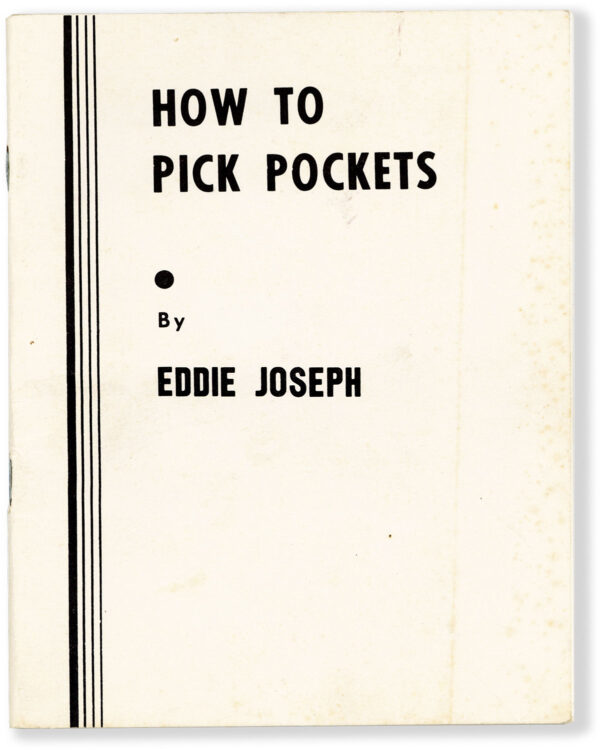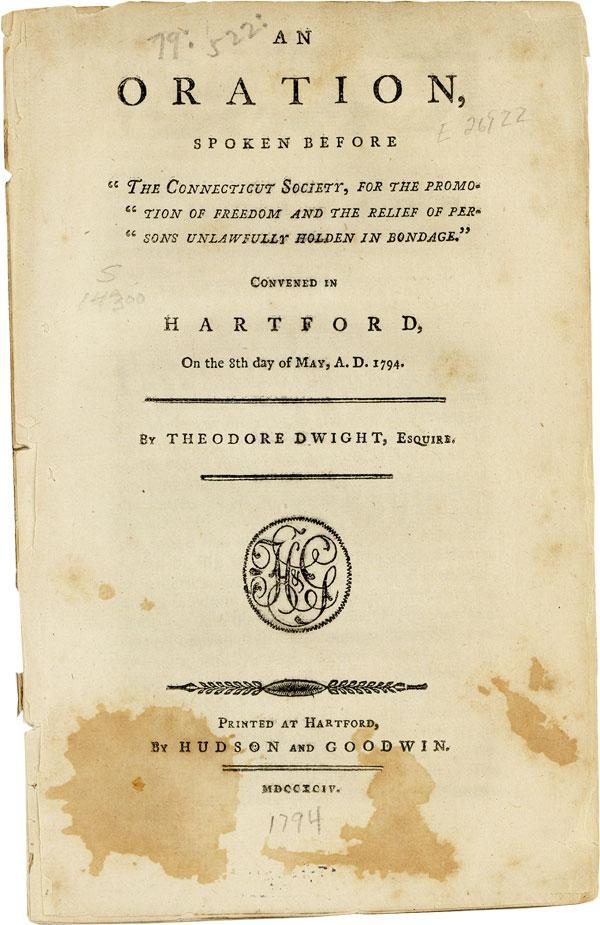
[US NAVY] VARIOUS
Five issues. 21cm. all running between 40 and 48pp. in length. Publihser's decorated card wraps, stapled. Clean, bright and fresh with some marginal light creasing and chipping to the covers of the February 1943 issue, otherwise a remarkably well preserved little handful of issues. Wartime on base (or onboard ship) printed newsletters and magazines were considered an important piece of morale building, typically produced by serving men and women, and containing everything from current news, to base gossip, to profiles of fellow service people, cartoons, comic strips and a number of other potential subjects. In general they were rather "thrown together" affairs, reflecting the unpredictable nature of serving during wartime, overseas, often in difficult circumstances; the Penguin News stands out as being a very professional piece of ersatz publishing, with decent print standards, numerous illustrations, photomontage effects and a general level of competence and attention to detail which sets it aside from the hand folded mimeo'd broadsheets that are often seen.

[POSTCOLONIAL LITERATURE] OYONO, Ferdinand (novel); REED, John (translation)
First Impression. Octavo (20.25cm); russet paper-covered boards, with titles stamped in silver on spine; dustjacket; [iv],2],3-140pp. Previous owner's ink name to front endpaper, hint of dust-soil to upper edge of textblock, else a clean, very Near Fine copy. Dustjacket is unclipped (priced 18s net), showing a hint of sunning to spine and some trivial wear to extremities; a bright, Near Fine example. First English-language edition of the Cameroonian author and statesman's first novel, originally published as Une Vie de Boy in 1956. The novel is centered around "the tragic life of Toundi Ondoua.a houseboy at the service of, successively, two white men: Father Gilbert and the commandant of the colony. The story is told in a double-voiced diary genre: written by Toundi but read by the Cameroonian Frenchman who was given Toundi's diary while witnessing the houseboy's untimely death in Spanish Guinea" (DAB, Vol.5, p.68). An attractive copy of a significant anticolonial work. 81476.

[POSTCOLONIAL LITERATURE] RHYS, Jean (pseud. of Ella Gwendoline Rees Williams)
First Impression. Octavo (20.5cm); red paper-covered boards, with titles stamped in gilt on spine; dustjacket; [4],5-189,[3]pp. Faint foxing to text edges, previous owner's ink name to front pastedown, with some gentle sunning to upper and lower board edges; Very Good+. Dustjacket is unclipped (priced 21s. net), showing some light wear to extremities, and faint foxing along the upper edge on verso; Near Fine. Rhys's postcolonial and feminist prequel to Charlotte Brontë's Jayne Eyre (1847), told from the point of view of Antoinette Cosway, Mr. Rochester's Creole wife. Winner of the WH Smith Literary Award in 1967, which brought Rhys to public attention after decades of obscurity. [81478].

STYRON, William
First Printing, trade issue. Octavo (22cm); black cloth, with titles and author's facsimile signature stamped in silver, gilt, and orange on spine and front cover; brown topstain; dustjacket; xvi,428,[2]pp. Inscribed by Styron a few weeks after publication on the front endpaper to American artist and social realist painter Gregorio Prestopino (1907-1984): "To Gregorio Prestopino / best wishes, warm greetings / Bill Styron / Roxbury, Conn. / 10-24-67." Sunning to upper board edges, subtle fading to topstain, touch of dust-soil to covers, with a small circular stain to lower edge of textblock and some faint foxing to text edges; Very Good. Dustjacket is unclipped (priced $6.95), showing modest shelfwear, some sunning to spine, mild handling, and a tiny scuff at the center of the front joint; Very Good+. Styron's fourth novel, set in the milieu of Nat Turner's four-day slave rebellion in Southampton County, Virginia in 1831. Winner of the Pulitzer Prize for Fiction in 1967. While Styron signed a great many copies of this book well into the waning years of his life, we have seen very few inscribed so close to the date of publication. BLOCKSON 5043. 81488.

Three pieces of promotional ephemera, produced for Ray Myers during the 1940's and later. Comprising: Pamphlet, 23cm x 15cm. Original grey card wraps, titled in black to front wrap. Clean and sharp with a small closed tear to the upper of the fore-edge, not interfering with text. Signed in pencil by Myers to a "Welcome" page at the front, underneath an image of the musician and his wife. Also present is a 2pp. loosely inserted song sheet. [with] A folded green card envelope, 16cm x 10cm. Titled in dark blue to front panel: "Souvenir Folder of Ray R. Myers 'The Armless Musician.'" Lightly sunned to edges, slight touches of wear and spotting to card, very good. Containing 9 black and white photographs of Ray Myers, arranged in a concertina format that folds out into a panorama of images of Mr. Myers performing mundane every day tasks without the benefit of arms. The general theme of his promotional material was to depict him driving, shooting, lighting a cigarette etc. [with] A folded brown card enevelope, 14.5cm x 10cm. Clean and sharp, inscribed by Ray R. Myers to the front panel: "Best Wishes, Ray R. Myers." Titled in black to rear closure flap; "Souvenir of Ray R. Myers." Containing 9 black and white phtographs of an older Mr. Myers, now in his 50's, playing guitar, composing with a keyboard, riding a small tractor, playing with his dog etc. Ray R. Myers was a celebrity steel guitarist and variety musician, born without arms, in Lancaster PA in 1911. Quickly showing musical aptitude, he was sent to a local community school after his parents maintained they wanted him to have as "normal" an upbringing as possible. Despite living in relative poverty, they rejected offers from large circuses and carnivals to take Roy in, and did their best to ensure he could make up his own mind as to what career he wished to pursue. Eventually, after the death of hs father relatively young, Roy did take up Ripley's "Believe it or Not Oddities" offer to perform and became somewhat of a musical celebrity and radio star, and by the 1950's he had a daily show on WPDX in West Virginia. [63910].

4to. 30cm x 23.5. Limited to 50 copies only. Publisher's grey paper-faced card portfolio, titled to a paper label applied to the front panel, minor rubbing and scuffing to extremities, purely superficial, and a little soiling to the white paper label. Portfolio perhaps a trifle flattened, but essentially a very good, clean copy indeed. Inside cand be found 10 25cm x 20cm silver gelatine prints consider iconically representative of Hine's work, a single sheet prospectus for the portfolio, a single sheet describing the contents, and a further single printed sheet with a timleline of Hine's career and a short suggested bibliography for further reading. Included are a number of Hine's best known and instantly recognizeable images, including his 1920 image of a young Power House mechanic, the 1931 image of The Empire State Building, and the 1905 image of a Slovak Woman at Ellis Island, carrying all of her worldly possessions on her back. A scarce collection of Hine's work, illustrating the full power of his imagery, and making it entirely clear how they could be so instrumental in bringing about radical change to, among other things, America's early 20th century Child Labor Laws. [63373].

AFRICAN-AMERICANA] DWIGHT, Theodore
Early such piece arguing against slavery, delivered by the Federalist lawyer and cousin of Aaron Burr. The Society was founded just four years previously, in 1790, and Dwight would work assiduously as an attorney representing free black New Yorkers who had been kidnapped to be placed on the slave market. "Although he wrote too much and too rapidly for lasting fame, his political articles were bright and spicy" ("Appleton's Cyclopaedia of American Biography (1888), Vol. II, p. 282). EVANS 26922; SABIN 21530. Octavo (19.5cm.); disbound; 24pp.; [A]-C4. Title page and last leaf of text (serving as upper and rear wrappers) separated but present, upper wrapper rather soiled, extremities chipped and a bit brittle. A Good, serviceable copy only.

First Printing. Octavo (21.75cm); red cloth, with titles stamped in black on spine and author's name in blind on front cover; dustjacket; xii,400,[4]pp. Inscribed by the author in a contemporary hand on the title page: "To Sally - Solidarity! Angela Y. Davis." Gentle sunning to spine ends and upper board edges, top edge dust-soiled, with lower corners bumped (though still sharp), and a small stain to lower right corners of the textblock; Very Good+. Dustjacket is unclipped (priced $8.95), spine-sunned and shelfworn, with a few tiny nicks, tears, and attendant creases, and a few faint dampstains toward base of spine; Very Good. Attractive, inscribed copy of Davis's autobiography. Written shortly after her imprisonment and trial in the Soledad brothers murder case (she was found not guilty), the volume chronicles her life from her childhood in Birmingham, Alabama to her rise to the FBI's list of the Ten Most Wanted Fugitives.

First Printing. Quarto (28cm); taupe cloth, blocked and titled in black on spine and front cover; dustjacket; unpaginated [96]pp; photographically illustrated. Gently spine-sunned, lightly shelfworn, with foxing to spine, joints, board edges, and upper edge of textblock; pronounced offsetting to gutters at endpapers from binder's glue, though text and illustrations are mostly clean; just Very Good. Dustjacket is unclipped (priced $2.50), spine-sunned, showing moderate wear, several chips, tears, and attendant creases, with a half-dozen or so tears archivally reinforced on verso; Good or better. One of the definitive photobooks of the 20th century and an essential title in any collection of books on the Spanish Civil War. The untitled jacket image, capturing the moment of death of a militiaman on the Cordoba front, established Capa's reputation as one of the great battlefield photographers of all time and remains one of the most recognizable photographs of the Twentieth Century. PARR-BADGER I:139. 81496.

Octavo (24cm) Two volumes in brown leather, single gold fillet around perimeter of boards, spines tooled in gilt with brown leather spine labels, all edges gilt; marbled endpapers, with turn-ins tooled in gilt; iv,278pp; [ii],ii,[294]pp; numerous black and white plates. Bound with the original front wrappers for issues 1, 7, and 12 (others omitted). A firm, handsome set with mild rubbing to edges, a few inital leaves professionally re-attached, generally Very Good indeed. Second iteration of the Aesthetic literary journal of the 1890s, complete. The first series was issued in 1893-94; this New Series was published by Grant Richards, a publisher known for his discerning taste (he published Shaw, Housman, Butler, and Joyce, and launched the World's Classic series now continued by Oxford). Particularly notable contributions to the journal include first appearances of an anonymous story by H. G. Wells, "A Vision of Judgment" (vol. II, p.21) and a story by Baron Corvo, "About What is Due to Repentance" (vol. I, p.267). Other contributing authors included Laurence Housman, Max Beerbohm, Nora Hopper (later Nora Chesson), Arthur Morrison, Allan Monkhouse, Norman Gale, Barry Pain, Riccardo Stephens, Henry Dawson Lowry, and Arthur Wimperis. Contributing artists included Joseph Pennell, S. H. Sime, Dion Clayton Calthrop, Leonard Raven-Hill, Maurice Greiffenhagen, and Martin Hardie; the journal also features two copies of prints by Hiroshige. The title is thought to be a reference to Whistler's butterfly signature. This cataloger also notes that the Butterfly features the most infuriatingly idiosyncratic pagination system we have ever encountered, a rampant defiance of the bibliographical fact that every leaf has two pages. But overall, a complete run of this charming example of Aesthetic literary and artistic style, from a tastemaking publisher. [63909].

First Printing. Octavo (21.5cm); two-tone yellow and blue cloth, with titles stamped in alternate colors on spine and front panel; dustjacket; [xiv],428pp. Tiny crimp to cloth at crown, faint foxing to upper edge of textblock, else a clean, very Near Fine copy. Dustjacket is unclipped (priced $3.95), with light wear to spine ends and extremities, and gentle sunning to spine; Near Fine. Petry's third novel, set in the fictional town of Monmouth, CT during a time ripe with racial tension. The story is centered around the disastrous love affair between a rich white girl and a black man. BLOCKSON 5932; COAN, p.192. 81402.

Folio (32cm). Brown cloth stamped in black and gilt, with large gilt view of the "Fleet" Works on rear board; pale floral patterned endpapers; [iv], 122pp; numerous wood engravings. Title page printed in four colors. Card of Representative H. C. Marquet, Nottingham, to front pastedown. A sound, upright copy, corners bumped, a few minor stains to cloth, rear free endpaper heavily browned, but interior generally clean and bright: Very Good. Detailed and extensively illustrated catalogue from a printing supply company; a valuable resource for studying or teaching about late nineteenth-century printing technologies. Robert Harrild, originally a printer, developed composition ink rollers in the 1810s, which were instrumental in the shift to cylindrical presses. He soon shifted from printing to manufacturing rollers and other printing supplies. By the 1890s, Harrild & Sons was a prosperous printing supply company; they also sold printing presses manufactured by Bremner of Otley in Yorkshire. This catalogue advertises lithographic and relief printing presses; folding machines; guillotines; ink rollers; printing types and rules; composing room furniture, including typecases, composing frames, imposing stones, and form racks; chases and furniture; stitching machines and binding equipment; stereotype manufacturing equipment; and a wide variety of other miscellaneous supplies, most illustrated in clear detail. [63976].

Corner-stapled, mimeographed sheets on standard bond, 11" x 8-1/2"; first document 23pp, second document 4pp. Faint toning, corner-crease, still Near Fine. "This We Can Do" includes a full program of the conference, followed by a series of action items, reading lists, and contact information for sponsoring organizations. The second document is comprised of twenty questions about labor history and contemporary events, presented in multiple-choice format. The questions range from the general ("The Industrial Revolution consisted of.?") to the highly specific ("What booklet was widely distributed to Ohio Jewish citizens by the State C.I.O. Council?). Rare, evocative, and a great piece of pre-War Ohio labor history.


